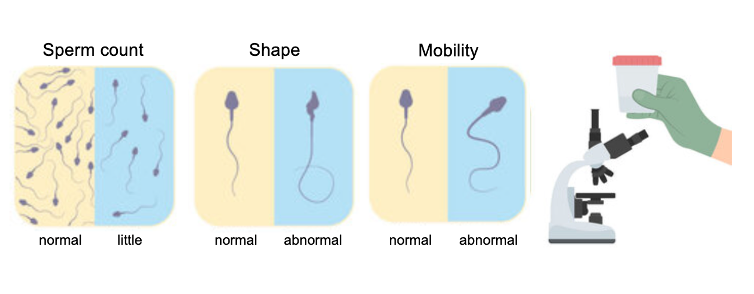Reproduction is a fundamental aspect of human existence, and when challenges arise, understanding the underlying factors becomes crucial. One such diagnostic tool that plays a pivotal role in assessing male fertility is semen analysis. In this comprehensive guide, we’ll delve into the intricacies of semen analysis, exploring its importance, the process, and what the results mean for individuals and couples.
Definition of Semen Analysis
Semen analysis is a diagnostic procedure that involves evaluating the composition and health of semen, the fluid carrying sperm, and other seminal components.
Importance of Semen Analysis in Reproductive Health
Understanding the significance of semen analysis is the first step in addressing fertility concerns. It provides valuable insights into male reproductive health and aids in identifying potential issues.
Why Semen Analysis is Conducted
Evaluating Male Fertility
Semen analysis is a cornerstone in assessing male fertility, helping to determine the ability of sperm to fertilize an egg.
Identifying Potential Issues
By conducting semen analysis, healthcare professionals can identify issues such as low sperm count, poor motility, or abnormal sperm morphology.
Preparation for Semen Analysis
Lifestyle Factors
Certain lifestyle factors, including diet, exercise, and substance use, can impact semen quality. Understanding these factors is crucial for accurate analysis.
Abstinence Period
Maintaining an appropriate abstinence period before providing a semen sample is essential for obtaining accurate results.
Sample Collection
The process of collecting a semen sample is relatively simple but requires adherence to specific guidelines to ensure accuracy.

Components Analyzed in Semen
Sperm Count
Semen analysis assesses the number of sperm present in a given sample, a key factor in fertility.
Motility
Sperm motility, or their ability to move effectively, is another critical parameter analyzed in semen samples.
Morphology
The shape and structure of sperm, known as morphology, provide insights into their health and potential to fertilize an egg.
Other Parameters
Beyond the basics, semen analysis may also assess other parameters like pH levels and volume.
Interpreting Semen Analysis Results
Normal vs. Abnormal Findings
Understanding the difference between normal and abnormal semen analysis results is essential for informed decision-making.
Potential Implications for Fertility
Abnormal results may indicate fertility challenges, but they are not definitive proof. Additional tests and consultations with specialists are often required.
Common Misconceptions
One-Time Analysis vs. Multiple Tests
It’s crucial to dispel the myth that a single semen analysis provides a definitive diagnosis. Multiple tests may be needed for a comprehensive understanding.
Factors Affecting Results
Various factors, including recent illnesses or medications, can influence semen analysis results. Understanding these factors is key to accurate interpretation.
Improving Semen Quality
Lifestyle Changes
Adopting a healthy lifestyle can positively impact semen quality. This includes maintaining a balanced diet, regular exercise, and avoiding harmful substances.
Medical Interventions
In some cases, medical interventions, such as fertility medications or surgical procedures, may be recommended to address specific issues affecting semen quality.
The Role of a Specialist
Consulting with a Reproductive Endocrinologist
When semen analysis results raise concerns, seeking the expertise of a reproductive endocrinologist is essential for further evaluation and guidance.
Further Diagnostic Procedures
Additional diagnostic tests, such as hormone evaluations or imaging studies, may be recommended to gain a comprehensive understanding of the underlying causes.
Emotional Impact of Semen Analysis
Coping with Results
Receiving semen analysis results, especially if they indicate potential fertility challenges, can be emotionally challenging. Finding healthy coping mechanisms is crucial.
Support Systems
Building a strong support system, including partners, friends, and mental health professionals, can significantly aid individuals and couples navigating fertility concerns.
Get to know us better
If you are reading this, you are in the right place – we do not care who you are and what you do, press the button and follow discussions live

Addressing Infertility as a Couple
Importance of Open Communication
Open and honest communication between partners is vital when facing fertility challenges. Mutual support fosters resilience and strengthens relationships.
Seeking Professional Help Together
Navigating fertility concerns is a shared journey. Seeking professional help together ensures both partners are actively involved in the decision-making process.
Advances in Semen Analysis Techniques
Technological Innovations
Ongoing research and technological advancements continue to enhance the accuracy and reliability of semen analysis, offering hope for improved diagnostic capabilities.
Research and Development
Investigations into novel techniques and treatments are paving the way for more effective interventions in addressing male infertility.
Real-Life Success Stories
Overcoming Fertility Challenges
Real-life stories of individuals or couples overcoming fertility challenges after thorough semen analysis provide inspiration and hope.
Positive Experiences with Semen Analysis
Sharing positive experiences related to semen analysis can alleviate anxiety and encourage others to seek timely evaluations.
Legal and Ethical Considerations
Privacy and Confidentiality
Respecting the privacy and confidentiality of individuals undergoing semen analysis is a legal and ethical imperative.
Informed Consent
Ensuring individuals are fully informed and provide consent before undergoing semen analysis is a fundamental ethical consideration.
Conclusion
Recap of Key Points
Semen analysis is a valuable tool in assessing male fertility, providing insights into sperm count, motility, morphology, and other crucial parameters.
Encouragement for Seeking Professional Advice
Individuals and couples facing fertility concerns are encouraged to seek professional advice promptly. Timely intervention can significantly improve the chances of successful outcomes.
FAQs about Semen Analysis
- How often should semen analysis be done?
Regular semen analysis may be recommended, especially for couples trying to conceive. However, the frequency can vary based on individual circumstances.
- Can lifestyle changes improve semen quality?
Yes, adopting a healthy lifestyle can positively impact semen quality. This includes maintaining a balanced diet, regular exercise, and avoiding harmful substances.
- What factors can affect sperm motility?
Various factors, including temperature, hormonal imbalances, and certain medications, can influence sperm motility.
- Is semen analysis painful?
No, semen analysis is a non-invasive and painless procedure. It involves providing a semen sample, usually through masturbation.
- Can abnormal results be treated?
Treatment options depend on the specific issues identified. Lifestyle changes, medications, or assisted reproductive technologies may be recommended.


















Comments
Thank you. Comment sent for approval.
Something is wrong, try again later